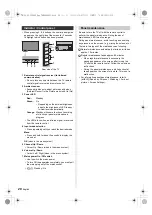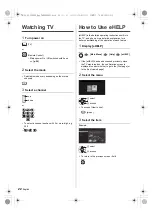
8
English
∫
Radio waves
≥
Do not use the TV and the remote control in any
medical institutions or locations with medical
equipment. Radio waves may interfere with the
medical equipment and may cause accidents due to
malfunction.
≥
Do not use the TV and the remote control near any
automatic control equipment such as automatic doors
or fire alarms. Radio waves may interfere with the
automatic control equipment and may cause
accidents due to malfunction.
≥
Keep at least 15 cm away from the TV and the remote
control if you have a cardiac pacemaker. Radio waves
may interfere with the operation of the pacemaker.
≥
Do not disassemble or alter the TV and the remote
control in any way.
∫
Built-in wireless LAN
≥
Do not use the built-in wireless LAN to connect to any
wireless network (SSID
*
) for which you do not have
usage rights. Such networks may be listed as a result
of searches. However, using them may be regarded
as illegal access.
≥
Do not subject the built-in wireless LAN to high
temperatures, direct sunlight or moisture.
≥
Data transmitted and received over radio waves may
be intercepted and monitored.
≥
The built-in wireless LAN uses 2.4 GHz and 5 GHz
frequency bands. To avoid malfunctions or slow
response caused by radio wave interference when
using the built-in wireless LAN, keep the TV away
from other devices that use 2.4 GHz and 5 GHz
signals such as other wireless LAN devices,
microwave ovens, and mobile phones.
≥
When problems occur due to static electricity, etc., the
TV might stop operating to protect itself. In this case,
turn the TV off at the Mains power On / Off switch,
then turn it back on.
∫
Bluetooth
®
wireless technology
≥
The TV and the remote control use the 2.4 GHz radio
frequency ISM band (Bluetooth
®
). To avoid
malfunctions or slow response caused by radio wave
interference, keep the TV and the remote control away
from the devices such as other wireless LAN devices,
other Bluetooth
®
devices, microwaves, mobile phones
and the devices that use 2.4 GHz signal.
∫
Ventilation
Allow sufficient space (at least 10 cm) around the TV in
order to help prevent excessive heat, which could lead to
early failure of some electronic components.
≥
Whether you are using a pedestal or not, always
ensure the vents at the bottom of the TV are not
blocked and there is sufficient space to enable
adequate ventilation.
∫
Moving the TV
Before moving the TV, disconnect all cables.
≥
At least two people are required to move the TV to
prevent injury that may be caused by the tipping or
falling of TV.
≥
Do not hold the screen part as shown below when
moving the TV. This may cause malfunction or
damage.
How to carry the TV.
≥
Transport only in upright position. Transporting the TV
with its display panel facing upwards or downwards
may cause damage to the internal circuitry.
∫
When not in use for a long time
This TV will still consume some power even in the Off
mode, as long as the mains plug is still connected to a
live mains socket.
≥
Remove the mains plug from the wall socket when the
TV is not in use for a prolonged period of time.
SSID is a name for identifying a particular wireless
network for transmission.
Warning
Caution
Caution
≥
Ventilation should not be
impeded by covering the
ventilation openings with items
such as newspapers,
tablecloths and curtains.
Caution
10
10
10
10
(cm)
Caution
Caution
TH-55_65JZ980Z_Eng_TQB4GA0053.book 8 ページ 2021年4月5日 月曜日 午後1時54分








































